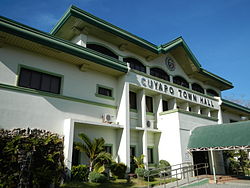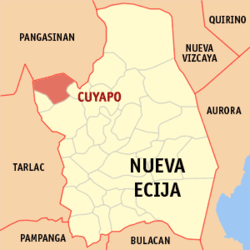Cuyapo
| Cuyapo | ||
|---|---|---|
| Municipality | ||

Cuyapo Town Hall
|
||
|
||
 Map of Nueva Ecija showing the location of Cuyapo |
||
| Location within the Philippines | ||
| Coordinates: 15°47′N 120°40′E / 15.783°N 120.667°ECoordinates: 15°47′N 120°40′E / 15.783°N 120.667°E | ||
| Country | Philippines | |
| Region | Central Luzon (Region III) | |
| Province | Nueva Ecija | |
| District | 1st District | |
| Founded | 1859 | |
| Barangays | 52 | |
| Government | ||
| • Mayor | Dr. Flor Esteban Paguio | |
| Demonym(s) | Cuyapeño (Cuyapenyo) | |
| Time zone | PST (UTC+8) | |
| ZIP code | 3117 | |
| IDD : area code | +63 (0)44 | |
| Income class | 1st class; rural | |
| Website | www |
|
Cuyapo is a first class municipality in the province of Nueva Ecija, Philippines. According to the 2010 census, it has a population of 59,396 people.
Cuyapo is politically subdivided into 51 barangays.
Cuyapo comes from the Pangasinan word “kuyapo”, “kiapo” or “quiapo” in Tagalog; “lul-luan”, in Ilocano; (Pistia stratiotes), a water plant that looks like a flower. According to the Kulantong, or Cronologia written by Cirilo R. Sumangil, a native of Cuyapo, who, for over forty years, was the Parish Priest of the Philippine Independent Church of Cuyapo. Said aquatic plant was so abundant particularly in a place which is now owned by the Monteros, situated along Rizal Street near the Municipal Cemetery. It was at this place that lured cow tenders from Paniqui, Tarlac to pasture their herds or flocks.
Pangasinenses from Paniqui, Tarlac who used to pasture their cattle, foresters from Sta. Maria, Narvacan, Ilocos Sur; Paoay and Batac in Ilocos Norte; and Pangasinenses from Calasiao and San Carlos, Pangasinan, settled in great number in the town. It is said that the exodus, particularly from Ilocos Sur, was due to the forced labor enforced by the Spaniards in the construction of the Catholic Church in Sta. Maria, Ilocos Sur. Cuyapo was declared a Barrio of Rosales on September 25, 1849, with Senior Santiago Vergara as its first Teniente del Barrio. Rosales was then a part of Nueva Ecija. It was in 1901 during the American Civil Commission that Rosales, together with Balungao, Umingan, San Quintin, were segregated from Nueva Ecija and became parts of Pangasinan.
...
Wikipedia


